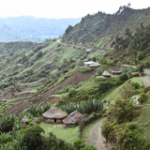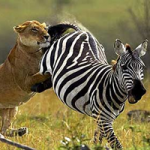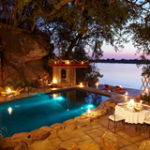STAYING HEALTHY, strong, warm, cheerful and alert helps ensure the success of your expedition. All these things depend on eating properly. NUTRITION and HYDRATION play essential roles in keeping you warm. The energy for everything you do is obtained from the food you at. Carbohydrates burn quickly. Fats, on the other hand, take
up to three hours to kick in, but they provide twice as much energy per gram as carbohydrates. In cold weather BREAKFAST is critical to maintain energy and warmth over the course of the day. Eat a power breakfast containing lots of carbohydrates. Eat fats at bed time to have body fuel early in the morning when the carbohydrates
have metabolized. When conditions are harsh, a proven strategy is to snack all day long and throughout the night.
HYDRATION
On Mt. Kenya daytime conditions are very warm which means walkers will perspire considerably. If a breeze is blowing, you may not even notice the sweat. Even during cold or wet weather on the mountain you will still perspire more than usual. Cold temperatures increase urinary output, thus accelerating dehydration. Hydration is integral to heat production. Water makes up from ½ to 1/3 of your body weight. A well hydrated body utilizes its food more efficiently and has better circulation. Your need for water increases with exercise due to sweat and water lost fro breathing hard. If lost fluids are not replaced, you could begin to suffer from dehydration. The first symptom is THIRST which signals that your body is already short two litres of water. Dehydration causes big time headaches, muscle cramps and nausea. It can increase your susceptibility to hypothermia, frostbite and altitude. At altitude (7000 ft plus), drink a minimum of water a day. This liquid may be taken in part in soup, herbal tea, Milo or acid type fruit drinks which one seems to crave at higher elevations. Coffee and tea are diuretics so use them in moderation. A drinking bottle filled with hot water bottle and a ready source of liquid in the night. Remember to screw the lid on tightly. Your urine will be copious and clear if you are well hydrated.
SAFE WATER
Ensure that the use of bottle water you are drinking is clean and free from contamination – Bottled water is recommendable. Water boils at 212 F at sea level. Giardia and most other water waterborne pathogens are killed at 140 F so when small bubbles appear before the real boil, water is safe to drink. Pathogens are also killed in the cooking process. For drinking water, most people use filter or treat with iodine such as puratabs. A 1 gal. Collapsible water carrier is useful as it saves having to go for water many times.
ENVIRONMENTAL CONSIDERATIONS
Part of planning ahead and preparing involves repackaging your food to minimize potential litter as well as to lighten your load. Cardboard, paper, foil, and tins are all excess weight and unnecessary. Take them off and BAG YOUR FOOD in two-ply clear plastic bags. They are lightweight, reusable and allow you to see what is inside. Do not pull the knots too tight on the food bags or you will never get them open again on the mountain. Small plastic bottles with screw lids are good for spices. Wide mouthed Nalgene containers are good for honey, peanut butter and margarine.
COOKING AT AN ALTITUDE
Since the time needed to boil water doubles for each 5,000ft increase in elevation, a ten minute meal at sea-level requires 40 minutes at 10,000 ft you’ll want to create simple one pot meals that require little preparation and clean up. Carbohydrates are appealing and more easily digested than proteins or fats at high altitude.
FITTING MOUNTAIN BOOTS
IN TERMS OF PREVENTING FOOT PROBLEMS it is important to have a good fit and a well-broken-in boot. To check your boots for the proper fit, read the following guidelines carefully. BOOTS SHOULD FIT COMFORTABLY WHEN WORN WITH TWO PAIR OF THICK WOOL SOCKS. Two pair of socks provides warmth, cushioning, reduce friction and
wick moisture away from the feet. A liner sock, or so called wicking, may be worn if you prefer but the liner sock is optional and should not be considered a substitute for rag wool socks. If you wear prescription arch supports or other orthopaedic devices make sure you have a good fit with the support in the boot.
BEGIN BY SELECTING A BOOT THE SAME SIZE AS YOUR NORMAL SHOES. Slip your bare foot into the boot and slide your foot forward until the toes touch the front of the boot. If you prefer you may wear a thin liner sock to perform this test. With the toes at the front of the boot, lean forward slightly; see if you place your index finger between your heel and the back of the boot. If you can’t, the boot is too small and should try a larger size. IF THE BOOT PASSES THE ABOVE TEST wear two pair of thick wool and lace the boots comfortably snug. Take a few steps. The toes should be comfortable, not too tight, with a bit of room to wiggle. The boot should feel comfortable in the arch, with a bit of support but not too tight. Taking steps, your heel should feel like it is being held snugly in the boot, with just enough lift so that your heel feels like it is just losing contact with the insole of the boot. Positively no lift is too tight; a half inch or more is too loose.
SAFETY ON THE MOUNTAIN
With access to the peak area of Mt. Kenya being so easy, at least when contrasted with other high mountains in the world, the climber or walker on the Mt. Kenya / Kilimanjaro are confronted with certain unique and potentially serious problems. These problems are almost always related to high altitude and acclimatization. The most common problem
is Acute Mountain Sickness [fusion_builder_container hundred_percent=”yes” overflow=”visible”][fusion_builder_row][fusion_builder_column type=”1_1″ background_position=”left top” background_color=”” border_size=”” border_color=”” border_style=”solid” spacing=”yes” background_image=”” background_repeat=”no-repeat” padding=”” margin_top=”0px” margin_bottom=”0px” class=”” id=”” animation_type=”” animation_speed=”0.3″ animation_direction=”left” hide_on_mobile=”no” center_content=”no” min_height=”none”][AMS]. The incidence of appetite loss, headache, nausea and vomiting are high, affecting at least 80% of climbers that reach the Austrian Hut area [4,800m] or even at the Mackinder’s camp [4,100m]. Certainly over half the visitors will feel a little “rough”.
FITNESS is a paramount to success on your limb. Any walker who has pre-existing pulmonary or cardiac problems should be extremely cautious about going up mt. Kenya. In preparation for your climb you might consider several long “practice” walks, preferably with long, uphill sections. If possible, use the same footwear on the walks that you intend to use on the mountain, and carry a light pack.
Please note that in general the faster you ascend, the more likely you are to feel the effects of altitude. In order to encourage visitors to spend longer on the ascent, particularly
those on a tight budget, the park authorities have recently reduced park entry fees for walkers on multi day trips.
HAPE and HACE times above 3,000m. They are essential when crossing snow or ice. Snow blindness is a very painful experience. Eye drops may help ease this, but the only
real cure is to keep damaged eyes bandaged for 24 hours or more.
BLISTERS are another common climber’s complaint. It is important that one chooses walking boots that fit comfortably; that is, not too small, and with enough room for thick socks and flexibility. If it feels like a blister or “hot spot” is beginning, remove the boot immediately and cover the sore in mole skin or gel tape. Toe nails should be kept as short as possible.
TRAUMA usually results from a broken limb or other major injury. Medication should not be given unless the pain is extreme, for the victims ability to cooperate or make decisions is reduced. (High altitude pulmonary and cerebral edema). Some specific high altitude problems are caused through the inability of human body to adjust to a rapid gain in altitude. Problems range from mild cases of AMS to the often fatal Pulmonary and Cerebral Oedemas. Not very much is known as to why certain people have a predilection for developing Oedema and not others, but what is known is that Oedema is not very common, and tends to affect young, fit males who over exert themselves. Symptoms of AMS usually follow in this order: headache, nausea, vomiting, anorexia, exhaustion, and lassitude, muscle weakness, a rapid pulse rate even while resting (+120/ min), insomnia, swelling of the hands and feet and reduced urine output. Although climbers may experience few to many of these symptoms, those with severe symptoms MUST stop ascending and consider moving to a lower altitude. Often a drop of as little as 500m will instantly relieve the symptoms of AMS. It is also good idea to remain at a lower altitude for a day or so in order to acclimatize before ascending again. Use of the drug DIAMOX, a diuretic, can help prevent or reduce the severity of AMS, but one should significantly increase their intake of water if using this drug.
With HAPE, additional symptoms may be noticed, such as shortness of breath (even at rest), gurgling bubbling sounds in the lungs and even watery blood-tinged sputum. Skin may be cold and clammy, lips and fingernails blue in colour. With HACE, severe headaches, hallucinations and lack of coordination are also possible. Treatment must be immediate. DESCEND! This must be done at night. The speed at these two conditions kill is as little as twelve hours from when the symptoms became apparent. If bottled oxygen is available, it should be used. There are also precautions one can take in order to reduce the risk of these problems. It is a good idea to spend one night at 3,000m and another at 4,200m. Also it is important to keep a slow, steady pace. Do not try and compete for time. The walking time between huts is seldom more than six hours. Drink at least 5 to 7 litres of fluid each day. Dehydration, even mild, leads to a thickening of the blood with increased possibility of pulmonary embolism or thrombosis. Urine colour should be pale and the output copious.
EXPOSURE OR HYPOTHERMIA is the lowering of the body core temperature. Prevention of exposure is simple. Use appropriate, good equipment. Do not allow clothing to become wet. When at rest, keep out of the wind. Treatment of exposure is simple but needs to be carried out quickly. If a hut or natural shelter is not close by, a tent, bivi bag
or similar protection should be arranged to keep the victim dry. All wet clothing should be removed, and the victim placed in a sleeping bag, preferably with another person inside, as close skin to skin contact is the best way of reviving a very low core temperature. Once the victim is conscious, hot drinks will go along way towards boosting morale.
FROSTBITE, though unlikely to kill, can result in serious water loss or at worst amputation. The fingers and toes are at greatest risk, and one can determine whether they are affected by frostbite either by their colour (pale white) or by the victim’s lack of sensation in the suspected area. Mittens, hats and face masks (or balaclavas) are a must.
SUN RELATED INJURIES: As about 40%, of the Earth’s protective atmosphere is below an altitude of 4,000m. When climbing, far less of the suns ultra violet rays is filtered out and is at great risk of severe sunburn even through cloud cover. A good factor 25+ sunscreen is highly recommended. Similarly dark glasses or ski goggles are really important, and are best worn at all
PACKAGE INCLUDES: TRANSPORTATION IN A 4 X 4 SAFARI LAND CRUISER WITH AN ENGLISH SPEAKING DRIVER / GUIDE, FULL BOARD ACCOMMODATION IN THE LUXURY LODGES/CAMPS, PARK ENTRY FEES, GAME DRIVES, AIRPORT TRANSFERS AND AIRSTRIP TRANSFERS AND THE NAIROBI NORFOLK HOTEL OR SIMILAR ON THE FIRST NIGHT.PRICE DOES NOT INCLUDE: VISA FEES, AIRPORT TAXES, PERSONAL TRAVEL INSURANCES, BEVERAGES/MINERAL WATER, AND LUNCH ON THE LAST DAY, LAUNDRY, TIPPING & ANYTHING OF PERSONAL NATURE. – Spurwing [/fusion_builder_column][/fusion_builder_row][/fusion_builder_container]












